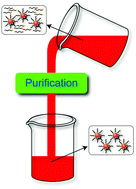Purification technologies for colloidal nanocrystals
Abstract
Almost all applications of colloidal nanocrystals require some type of purification or surface modification process following nanocrystal growth. Nanocrystal purification – the separation of nanocrystals from undesired solution components – can perturb the surface chemistry and thereby the physical properties of colloidal nanocrystals due to changes in solvent, solute concentrations, and exposure of the nanocrystal surface to oxidation or hydrolysis. For example, nanocrystal quantum dots frequently exhibit decreased photoluminescence brightness after precipitation from the growth solvent and subsequent redissolution. Consequently, purification is an integral part of the synthetic chemistry of colloidal nanocrystals, and the effect of purification methods must be considered in order to accurately compare and predict the behavior of otherwise similar nanocrystal samples. In this Feature Article we examine established and emerging approaches to the purification of colloidal nanoparticles from a nanocrystal surface chemistry viewpoint. Purification is generally achieved by exploiting differences in properties between the impurities and the nanoparticles. Three distinct properties are typically manipulated: polarity (relative solubility), electrophoretic mobility, and size. We discuss precipitation, extraction, electrophoretic methods, and size-based methods including ultracentrifugation, ultrafiltration, diafiltration, and size-exclusion chromatography. The susceptibility of quantum dots to changes in surface chemistry, with changes in photoluminescence decay associated with surface chemical changes, extends even into the case of core/shell structures. Accordingly, the goal of a more complete description of quantum dot surface chemistry has been a driver of innovation in colloidal nanocrystal purification methods. We specifically examine the effect of purification on surface chemistry and photoluminescence in quantum dots as an example of the challenges associated with nanocrystal purification and how improved understanding can result from increasingly precise techniques, and associated surface-sensitive analytical methods.

- This article is part of the themed collections: Frontiers in Nanocrystal Surface Chemistry and Most downloaded articles of 2017: Physical and Environmental Chemistry

 Please wait while we load your content...
Please wait while we load your content...